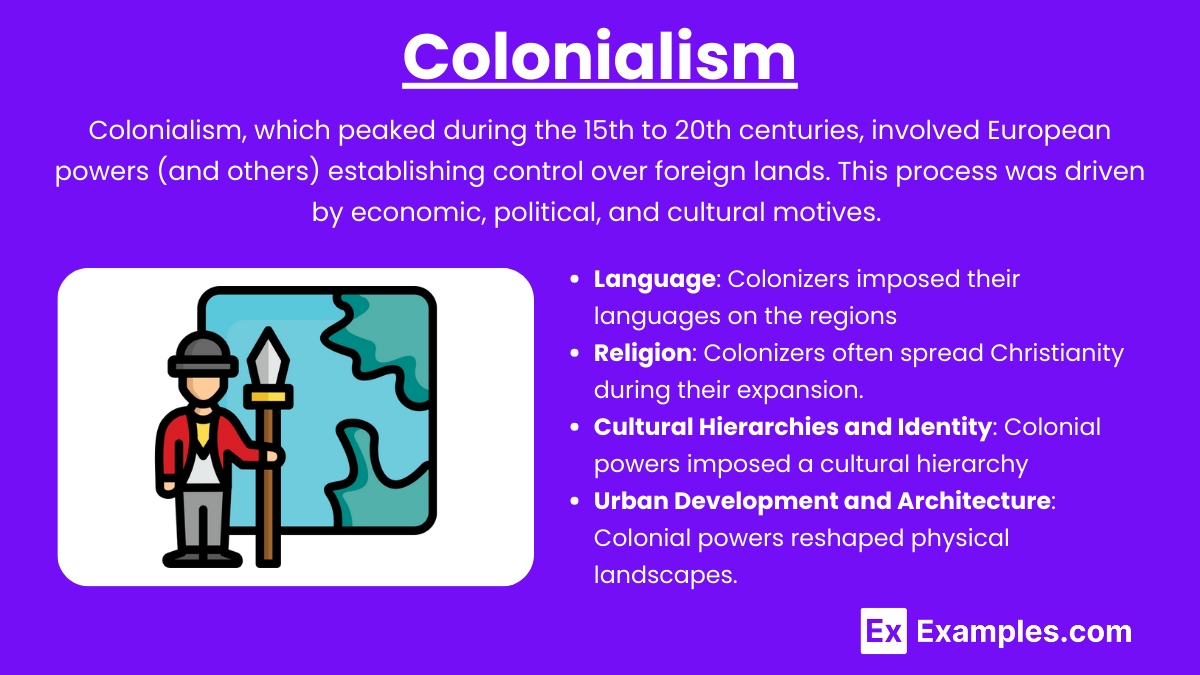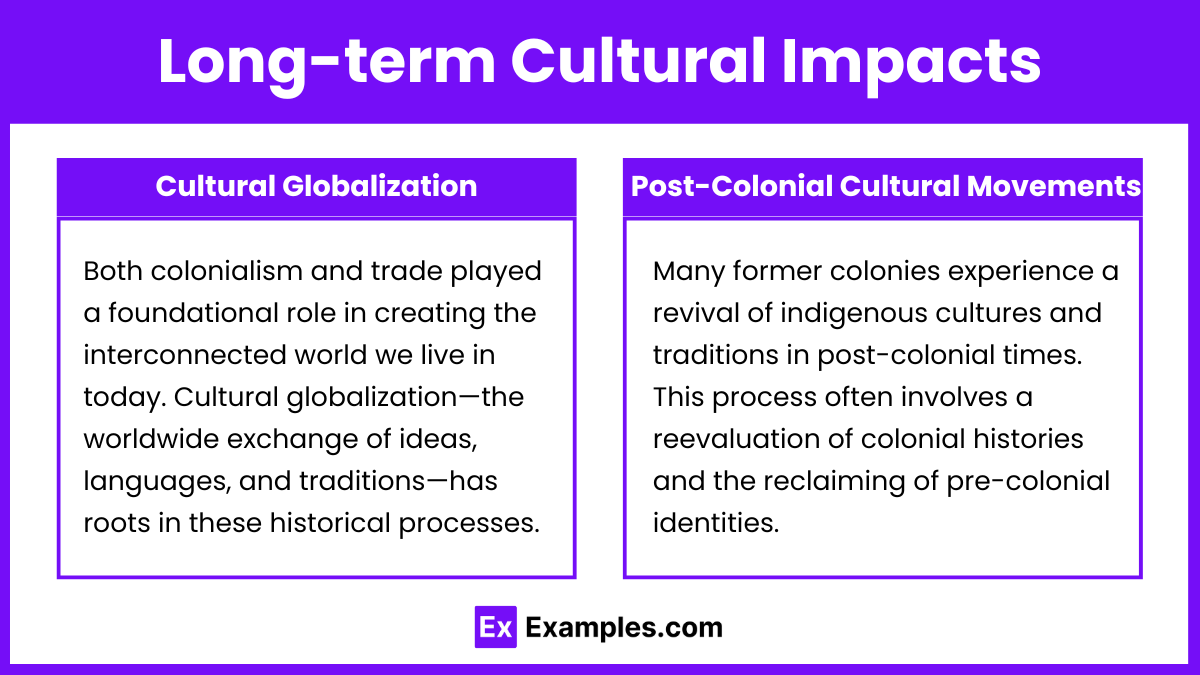Colonialism and trade have been powerful historical forces shaping cultural patterns worldwide. In AP Human Geography, colonialism, through conquest and control, spread European languages, religions, and political systems, leaving a lasting legacy on colonized regions. Trade, from ancient Silk Roads to modern global markets, facilitated the exchange of goods, ideas, and cultures, fostering cultural diffusion and syncretism. Both forces contributed to globalization, altering local traditions and blending diverse cultural elements. Understanding these impacts is crucial in analyzing how historical interactions shaped the modern cultural landscapes we see today.
Learning Objectives
In studying the topic of historical forces like colonialism and trade and their effects on cultural patterns for AP Human Geography, you should learn how these forces have shaped languages, religions, social hierarchies, and political boundaries across the world. Understand the role of cultural diffusion, syncretism, and globalization, as well as the lasting impacts of colonialism, including post-colonial cultural movements. Recognize how trade facilitated the exchange of goods, ideas, and technologies, leading to cultural blending, and examine how historical events influence contemporary global and regional cultural landscapes.
Historical Forces, Such as Colonialism and Trade, that Affect Cultural Patterns
Colonialism and trade have been two of the most significant historical forces shaping cultural patterns across the globe. Understanding these forces is essential for mastering AP Human Geography.
Colonialism

Colonialism, which peaked during the 15th to 20th centuries, involved European powers (and others) establishing control over foreign lands. This process was driven by economic, political, and cultural motives. The impact of colonialism on cultural patterns includes:
- Language: Colonizing powers imposed their languages on the colonized regions, often leading to a lasting legacy of linguistic dominance. For instance, English, French, Spanish, and Portuguese became widely spoken in Africa, the Americas, and Asia. Even after decolonization, these languages remain official in many countries, shaping educational systems, government, and media.
- Religion: Colonizers often spread their religion, particularly Christianity, as part of their mission. Many regions that were colonized by European powers have a significant Christian population today. This religious shift often replaced or significantly altered indigenous belief systems.
- Cultural Hierarchies and Identity: Colonial powers imposed a cultural hierarchy that placed Western norms, values, and customs at the top, often suppressing local cultures. This led to a loss of indigenous traditions, language, and social structures. In some cases, hybrid cultures emerged, blending local and colonial customs, particularly visible in food, clothing, and festivals.
- Urban Development and Architecture: Colonial powers reshaped the physical landscapes of their colonies by building infrastructure like roads, railways, and ports to extract resources and facilitate trade. European architectural styles became prominent in colonial cities, which can still be seen in places like India, Africa, and the Caribbean. Colonization also fostered the growth of urban areas as centers of administration, commerce, and European-style education.
Trade

Trade networks have played a crucial role in the spread and diffusion of cultural practices. Trade refers to the exchange of goods, services, and resources between different regions or countries.Trade routes such as the Silk Road, the trans-Saharan routes, and later the Atlantic trade routes connected distant regions, enabling the exchange of goods, ideas, and technologies. Trade impacts cultural patterns in the following ways:
- Cultural Diffusion: Goods, technologies, and ideas spread along trade routes. For example, the spread of Buddhism from India to East Asia occurred through trade networks. Islamic culture also spread through trade, especially in Africa, where traders from the Arab world influenced local cultures in terms of language, religion, and customs.
- Economic Influence on Culture: Trade networks often resulted in cultural dominance by powerful economic players. The prominence of Western consumer goods, media, and cultural products globally is an example of modern trade influencing cultural patterns. Globalization, accelerated by trade, has led to the rise of global popular culture, which often blends Western and local elements.
- Cultural Syncretism: Trade facilitated the blending of different cultures, resulting in new, hybrid cultural practices. For instance, the Columbian Exchange between the Old and New Worlds after the 15th century saw the exchange of crops, animals, and ideas, fundamentally altering diets, agriculture, and lifestyles across the world. Corn, potatoes, and tomatoes from the Americas became staples in European diets, while European wheat and domesticated animals changed the agricultural landscape of the Americas.
Long-term Cultural Impacts

- Cultural Globalization: Both colonialism and trade played a foundational role in creating the interconnected world we live in today. Cultural globalization—the worldwide exchange of ideas, languages, and traditions—has roots in these historical processes. However, this globalization often leads to cultural homogenization, where dominant cultures, particularly Western ones, overshadow local cultures.
- Post-Colonial Cultural Movements: Many former colonies experience a revival of indigenous cultures and traditions in post-colonial times. This process often involves a reevaluation of colonial histories and the reclaiming of pre-colonial identities.
Examples
Example 1: The Spread of the English Language through British Colonialism
During the British Empire’s expansion in the 18th and 19th centuries, English became a dominant language in many colonized regions, including India, Africa, and the Caribbean. Today, English serves as an official or second language in these areas, influencing education, business, and government. This linguistic dominance is a direct result of British colonial policies and has contributed to English being a global lingua franca.
Example 2: The Columbian Exchange and Cultural Syncretism
Following Christopher Columbus’s voyages to the Americas, the Columbian Exchange led to a massive exchange of goods, ideas, and diseases between the Old and New Worlds. Crops like potatoes, tomatoes, and corn from the Americas became vital to European diets, while European wheat, sugarcane, and domesticated animals changed the agricultural practices of the Americas. This trade exchange also introduced European customs and religious practices to indigenous cultures, leading to significant cultural syncretism.
Example 3: Islamic Culture in West Africa through Trans-Saharan Trade
The trans-Saharan trade routes connected North Africa to sub-Saharan Africa, facilitating the spread of Islamic culture to West Africa. Islamic traders not only exchanged goods like gold and salt but also introduced their religion, language (Arabic), and educational systems. Over time, Islam became a dominant cultural force in countries like Mali, Senegal, and Nigeria, influencing architecture, law, and governance.
Example 4: French Colonial Influence on Language and Culture in West Africa
France’s colonization of West African countries, including Senegal, Ivory Coast, and Mali, left a lasting impact on cultural patterns. French became the official language in these countries, used in education, administration, and business. French colonial rule also influenced local food, fashion, and legal systems, blending French cultural norms with local traditions. The Francophone identity continues to shape the cultural and political landscape of these nations.
Example 5: Cultural Globalization through Modern Trade and Western Media
In the modern era, global trade and the dominance of Western media have played a significant role in shaping cultural patterns worldwide. American movies, music, fashion, and technology have spread across the globe through trade and digital media platforms. This has led to the adoption of Western cultural norms, particularly in urban areas, affecting local traditions and creating hybrid cultures. The global spread of consumer culture is a direct outcome of modern trade practices.
Multiple Choice Questions
Question 1
Which of the following is a primary way that colonialism has shaped modern cultural patterns in former colonies?
A) Increased prevalence of indigenous languages in global media
B) The spread of Western European languages as official languages
C) The elimination of all religious practices except local indigenous beliefs
D) Complete removal of Western architectural influence in former colonies
Answer: B) The spread of Western European languages as official languages
Explanation: Colonialism led to the imposition of European languages (such as English, French, Spanish, and Portuguese) on colonized regions. These languages often replaced or coexisted with indigenous languages and became official languages in many countries. Today, many former colonies retain the colonial language for government, education, and business, contributing to a lasting colonial cultural legacy. For instance, English remains an official language in India, while French is used in many African countries. Options A, C, and D are incorrect because indigenous languages did not dominate global media, religious practices were not eliminated, and Western architectural styles remain visible in former colonies.
Question 2
How did trade routes, such as the Silk Road, influence cultural patterns across regions?
A) They isolated regions, preventing cultural diffusion.
B) They facilitated the exchange of goods but had little impact on cultural practices.
C) They allowed for the diffusion of religions, technologies, and ideas between distant regions.
D) They were primarily used for military expansion rather than cultural exchange.
Answer: C) They allowed for the diffusion of religions, technologies, and ideas between distant regions.
Explanation: Trade routes like the Silk Road connected distant regions, enabling not only the exchange of goods but also the diffusion of religions, technologies, and cultural practices. For example, Buddhism spread from India to China and beyond through trade networks, and new inventions like papermaking and gunpowder were shared across regions. Trade routes were major conduits for cultural diffusion, enhancing interactions between different civilizations. Option A is incorrect because trade routes connected rather than isolated regions. Option B underestimates the impact of trade on cultural practices, and D misinterprets the primary purpose of these routes, which was trade, not military expansion.
Question 3
Which of the following best describes the long-term impact of colonialism on political boundaries in Africa?
A) Colonial powers respected existing ethnic boundaries, resulting in peace post-independence.
B) Arbitrary borders drawn by colonial powers ignored ethnic divisions, leading to conflicts.
C) Colonial boundaries encouraged the unification of African ethnic groups into cohesive nations.
D) The end of colonialism saw the complete dissolution of colonial-era borders.
Answer: B) Arbitrary borders drawn by colonial powers ignored ethnic divisions, leading to conflicts.
Explanation: During the colonial period, European powers drew political boundaries without considering existing ethnic, linguistic, and cultural divisions in Africa. These arbitrary borders often split ethnic groups or forced rival groups into the same political entities. After independence, these boundaries remained largely unchanged, contributing to numerous internal conflicts, as ethnic groups struggled for power and control within artificially created states. Option A is incorrect because colonial powers did not respect ethnic boundaries. Option C is incorrect because colonial boundaries did not encourage unification but often caused divisions, and D is incorrect because colonial borders were not dissolved after independence; they persisted as national boundaries.


